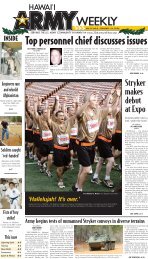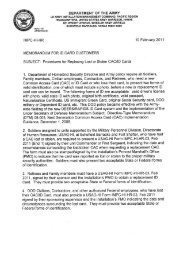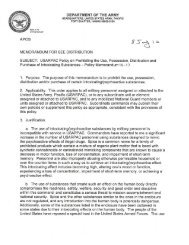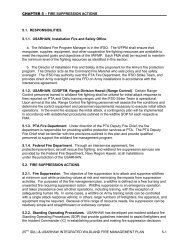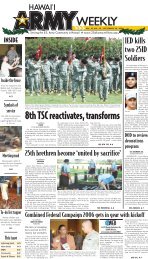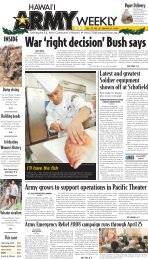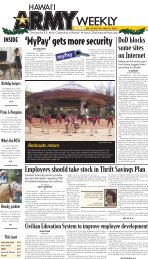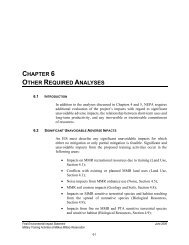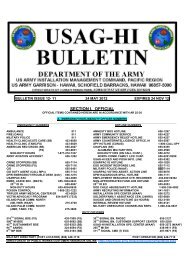Cover, Executive Summary, Table of Contents - U.S. Army Garrison ...
Cover, Executive Summary, Table of Contents - U.S. Army Garrison ...
Cover, Executive Summary, Table of Contents - U.S. Army Garrison ...
Create successful ePaper yourself
Turn your PDF publications into a flip-book with our unique Google optimized e-Paper software.
<strong>Executive</strong> <strong>Summary</strong><br />
� Proposed upgrades to Charlie’s Circle Road would provide safe access to an underutilized portion<br />
<strong>of</strong> the range that could later be used to enhance PTA’s training capability; and,<br />
� A proposed main supply route would be built to connect the main range area with the KMA.<br />
Utilities running through the range area and the Cantonment Area are currently meeting the installation’s<br />
energy and utility requirements, but would be entirely stressed to meet the demand that new ranges and<br />
proposed facilities in the Cantonment Area, if modernization <strong>of</strong> PTA is decided to occur. Utility upgrade<br />
requirements are:<br />
� Production Well;<br />
� Electrical upgrade.<br />
First Range Modernization Project: Construct and Operate the IPBA<br />
The <strong>Army</strong> proposes to co-locate, within the IPBA, an IPBC, Live-fire Shoothouse, and a MOUT facility.<br />
Co-locating these facilities would enable the infantry companies to maximize their limited training time<br />
and resources through simultaneous training <strong>of</strong> its platoons during deployments to PTA.<br />
An IPBC supports a variety <strong>of</strong> light infantry training events, day and night, such as reconnaissance and<br />
security; movement to contact; attack; raid; ambush; defend and retrograde. An infantry platoon training<br />
on the IPBC would move dismounted from objective to objective while engaging the targets with rifles<br />
(5.56 mm ammunition) and machine guns. The infantry platoon would normally conduct several practice<br />
runs without live ammunition prior to conducting a live-fire exercise.<br />
The proposed Shoothouse would be a two-story building <strong>of</strong> approximately 4,700 sf with ro<strong>of</strong> and<br />
stairways. It is divided into rooms and hallways <strong>of</strong> different sizes which contain automated precision<br />
human urban targets (HUT). All vertical surfaces would be covered with bullet absorbing wall panels.<br />
The Shoothouse would be used to train and evaluate individual Soldiers and squads on their ability to<br />
move tactically (enter and clear a room, enter and clear a building), engage targets, and conduct breaches,<br />
and practice target discrimination in a live-fire environment. Soldiers would use pistols, rifles and light<br />
machineguns, and shotguns. Units using the Live-fire Shoothouse may complete practice exercises<br />
before conducting a live-fire exercise.<br />
The MOUT site would be used to train small units such as patrolling, security operations, cordon and<br />
search, attack and defend. Friendly and enemy targets may be emplaced temporarily in the MOUT site,<br />
or the unit may conduct “force-on-force” exercises.<br />
ALTERNATIVES<br />
Because <strong>of</strong> its multi-tiered approach the <strong>Army</strong> reviews two levels <strong>of</strong> alternatives.<br />
Draft Programmatic Environmental Impact Statement ES-5<br />
Modernization <strong>of</strong> PTA and Construction and Operation <strong>of</strong> an IPBA



